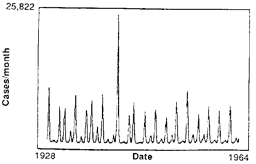 |
Science Frontiers ONLINE No. 62: Mar-Apr 1989 |
|
|
Measles epidemics: noisy or chaotic?
 The incidence of measles in New York City, 1928-1964. Noise or chaos? |
The growing split in scientific outlook is seen very clearly in the statistics of New York City measles epidemics before mass vaccinations. Take a look at the graph of recorded cases. The expected peaks occur each winter, but there is a strong tendency toward alternate mild and severe years.
Very nice mathematical models exist that purport to predict the progress of epidemics. They take into account such factors as the human contact rate, disease latency period, the existing immune population, etc. It is all very methodical, but it fails to account for the irregularities in actual data. Deterministic scientists claim that just by adding a little "noise" they could duplicate the observed curve. On the other hand, a very simple model that acknowledges the reality of chaos easily duplicates the measured data. Who is right? The determinists and chaosists (chaosians?) are now fighting it out.
(Pool, Robert; "Is It Chaos, or Is It Just Noise?" Science, 243:25, 1989.)
Comment. Much more of nature may be chaotic. Even evolution itself may be so. Are we merely a blip on a biological diversity curve, with a future that is unpredictable, regardless of what actions we take? Fortunately, lack of space prohibits the mention of Free Will!
Reference.See BHH2 in our catalog Biological Anomalies: Humans II for more on the periodicity of epidemics.